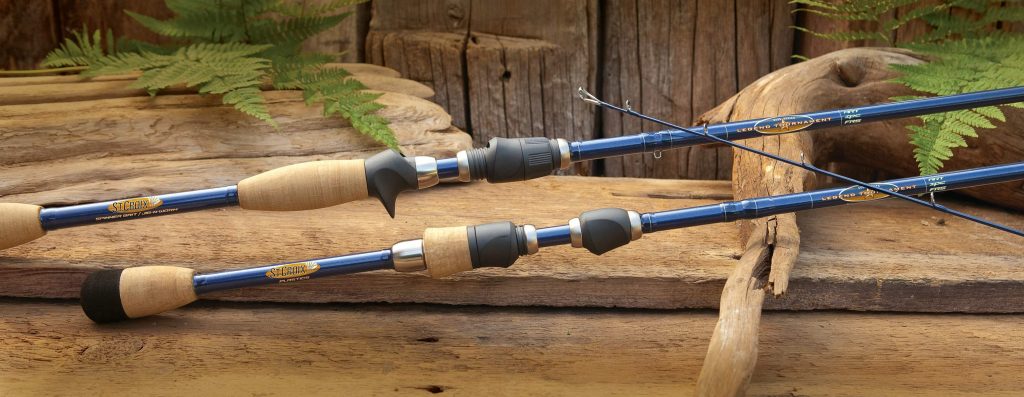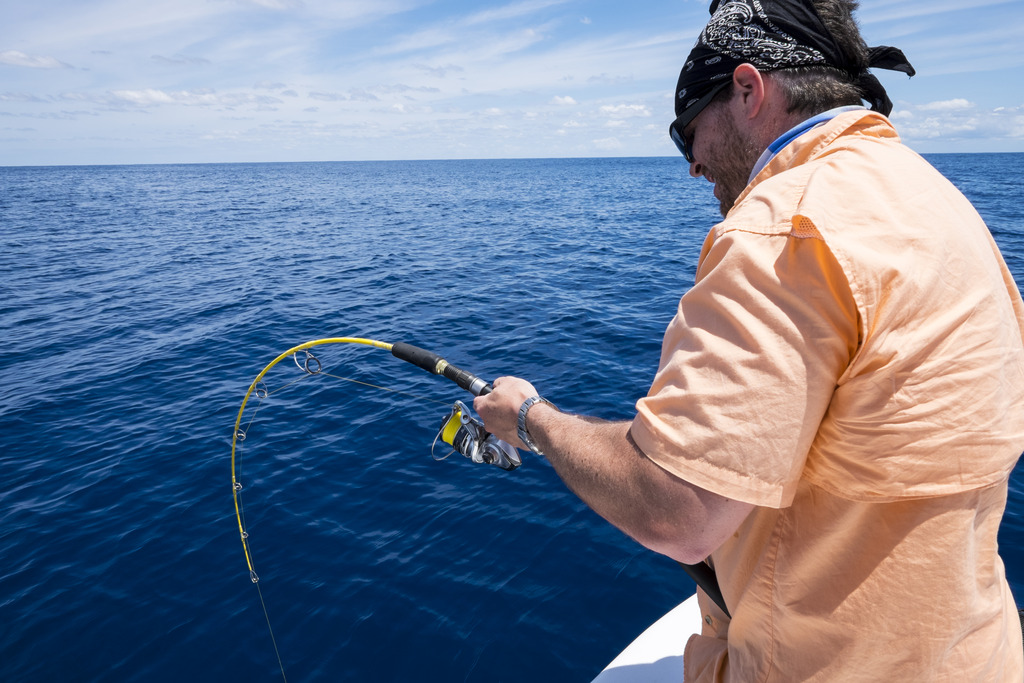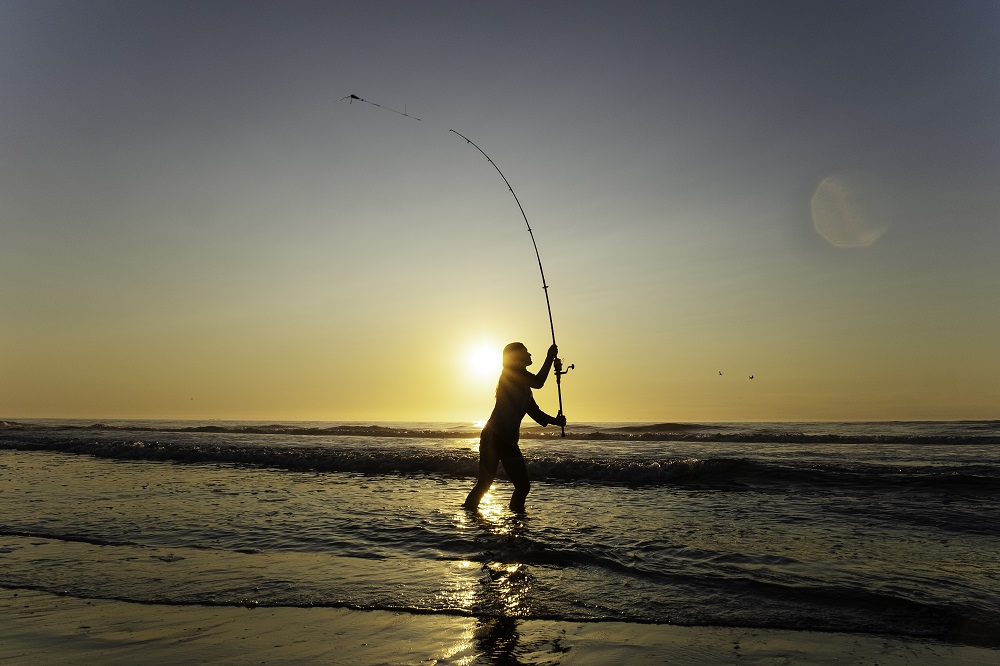

When you’re fishing with swimbaits, you’re typically looking for bites from the biggest bass in the lake. You need to be prepared when that big bite finally comes, which means having a rod that’s designed to handle swimbaits. Sure, your crankbait rod can probably handle small swimbaits. But once you get up into larger swimbaits that weigh more than a few ounces, you’ll need the best swimbait rod to avoid snapping your rod altogether.
Swimbait rods are significantly burlier than crankbait rods, but beyond that, there are a lot of important differences between them. The taper can play a big role in determining how responsive your rod is to your movements after a bite, while the length can impact how you cast with your swimbait rod. Swimbait rods also differ in the weight of lines and lures they can be used for, which is important because swimbaits are often large and heavy lures. Finally, the total weight of swimbait rods can vary dramatically, which can lead them to handle differently and tire you out more or less. We came up with a list of 6 best options, and the Okuma Guide Select A Series Swimbait Rod just tops them all.
More features: IM-8 graphite blank construction, stainless steel hook keepers, excellent sensitivity, lightweight ergonomic base for the reel
This impressive swimbait rod from Okuma is able to handle large swimbait lures. The rod features a moderate fast action, which is ideal for casting for larger bass. The rod’s power isn’t rated, but fishermen reported that the 1-6-ounce lure weight rating and 15-30-pound line weight rating are accurate. If you tend to fish larger swimbait lures, Okuma also makes a heavier version of this rod capable of handling lures up to 10 ounces.
The rod itself is made from an IM-8 graphite blank, with stainless steel hook keepers and 10 aluminum guides. Overall, users found the rod to be extremely well-balanced and comfortable to hold. It’s not the lightest swimbait rod at eight ounces, but this was hardly a problem for bass fishermen. The only common complaint was that the grip is shortened, and many fishermen prefer the flexibility of a full grip on the end of their rods. All in all, this is an amazing choice, which you can get without breaking the bank.
More features: high modulus graphite blanks, balanced for maximum sensitivity, high-density cork grip
This rod from Dobyns has impressed many fishermen with its amazing price. The rod is lightweight, at just 7.2 ounces, but it’s powerful enough to handle a huge range of line and lure weights. The fact that this rod can handle swimbait lures that are either two ounces or eight equally well is unusual, and it makes this a go-to swimbait rod no matter what bass you’re fishing for.
Users loved the fast action and 12 guides on this rod, particularly when casting far out from shore. The rod’s split cork grip is on the shorter end, which not every fisherman found to be ideally comfortable, but users agreed that the rod is well-balanced.
One thing to watch out for with this swimbait rod is the reel seat. The threads are short, so you’ll want to pay attention to whether your reel is slowly backing off the seat while fishing. Most users didn’t have a problem with this while reeling in a catch but did point to it as one of the only notable flaws with this rod.
More features: high modulus graphite, well-balanced, Carbon Nano Tube resin technology, Fuji guides with reel seats and WINN grips
This incredibly lightweight swimbait rod from KastKing could easily be mistaken for a crankbait rod if you didn’t know better. At just 7’6” and length and 4.45 ounces, this is by far the smallest and lightest rod that we reviewed. As a result, it’s also the most limited rod we reviewed in terms of power – it can only handle swimbait lures up to one ounce, which largely limits you to single-hook swimbait lures.
The truth is that there isn’t anything this rod can do that you can’t do with a dedicated crankbait rod. But, if you’re in the market for your first bass rod, this is an excellent all-around choice. Users love how this rod is balanced, and the WINN split grip feels excellent in your hands. 10 guides over the shorter length prevent your line from tangling and ensure that you’ll get accurate casts every time.
More features: lightweight design, balanced and sensitive, fatigue reduction, perfect strength to weight ratio
This high-end swimbait rod from G. Loomis combines all of the classic features of this rod class. The rod is eight feet in length, yet weighs just 6.4 ounces thanks to an incredibly durable carbon blank. Weight is further reduced by a thin split grip, although users found this to be quite comfortable and well-balanced in their hands.
The rod features a moderate fast taper, which is perfect for a wide range of swimbait casting and reeling. The lightweight design does somewhat limit this rod for going after the largest bass, but it offers plenty of power for the majority of bass fishermen. The rod is capable of handling lines up to 30 pounds and lures up to six ounces, which is what the vast majority of experienced swimbait fishers are using in most lakes.
More features: sensitive and durable graphite blanks, tangle-free K-guides with alconite inserts, increased casting performance
This premium rod from Dobyns offers high sensitivity and the ability to handle large lures for fishermen who want to cast after larger bass. Fishermen loved the fast action when casting because it allows you to launch heavy swimbait lures far out into the lake. With 12 tangle-free K-guides, fishermen noted that casting with this lure was surprisingly accurate and issues with your line tangling when reeling in were extremely rare.
The rod offers a powerful backbone – it’s capable of handling rods up to eight ounces in weight, and lines up to 40 pounds. The graphite blank is extremely durable and won’t bend much below the tip, which ensures that you can reel in heavy catches without damaging your rod.
Another thing that users loved about this rod is the handle. The full-length synthetic handle is extremely comfortable and balanced, while also offering excellent grip.
More features: cork split grip, IM8 graphite construction, Fuji aluminum oxide line guides, 3-year limited warranty
This shorter swimbait rod is ideal for beginners, smaller fish, and when you just don’t want to carry heavy fishing setup. The rod is just 7’6” in length and is outfitted with fully nine premium Fuji aluminum guides. On top of that, this is one of the lightest swimbait rods we’ve seen, weighing in at just 6.4 ounces.
Users loved the split cork grip on this rod for its comfort and balance, although some fishermen did wish for a full-length rod. The IM-8 graphite blank construction is extremely durable, which is good considering that the tip can bend quite a bit on this fast-action swimbait rod.
The only major limitation to the Denny Brauer rod is that it’s only rated for line weights up to 14 pounds. That’s not much if you’re casting after larger bass, but it’s plenty for targeting small and mid-sized bass.
Swimbait rods have a lot in common, but there are a lot of important distinctions among them. It’s important to understand these differences in order to make sure you’re getting the right swimbait rod. Your pick depends on the fish you’re trying to catch and the lures you want to use. In our buying guide, we’ll highlight the essential features of swimbait rods so you can make an informed choice.
There are a lot of considerations that go into choosing a swimbait rod. Many factors depend on your personal preferences and fishing experience. Here, we’ll take a look at the features you need to know about in order to get the best swimbait rod for you.
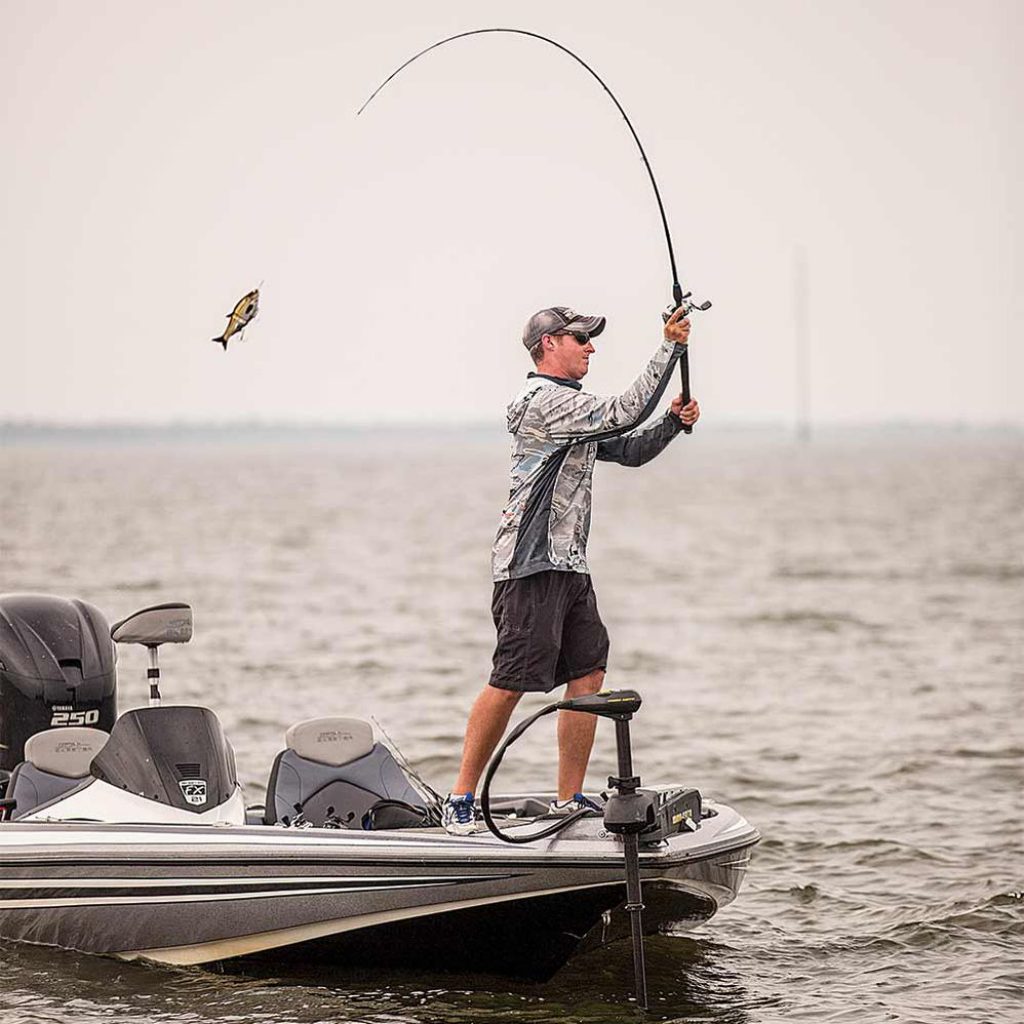
Faster action rods are recommended if you tend to use smaller swimbait lures with only a single hook. That way, the hook is faster to set into the fish’s mouth after they take a bit.
If you’re fishing with larger swimbaits with multiple hooks, a moderate fast rod is a better choice. That way, you reduce the chance of ripping the hook out of your fish’s mouth and losing them before you even start reeling.
A swimbait rod’s power, also called backbone, essentially describes how stiff it is. The more power swimbait rods have, the more resistant to bending they are as you’re reeling in a big fish. Swimbait rods should typically be rated as heavy or extra heavy since you need a rod that’s relatively stiff to handle the large lures. However, many manufacturers don’t advertise the power rating for their rods, so it’s important to check feedback from fishermen.
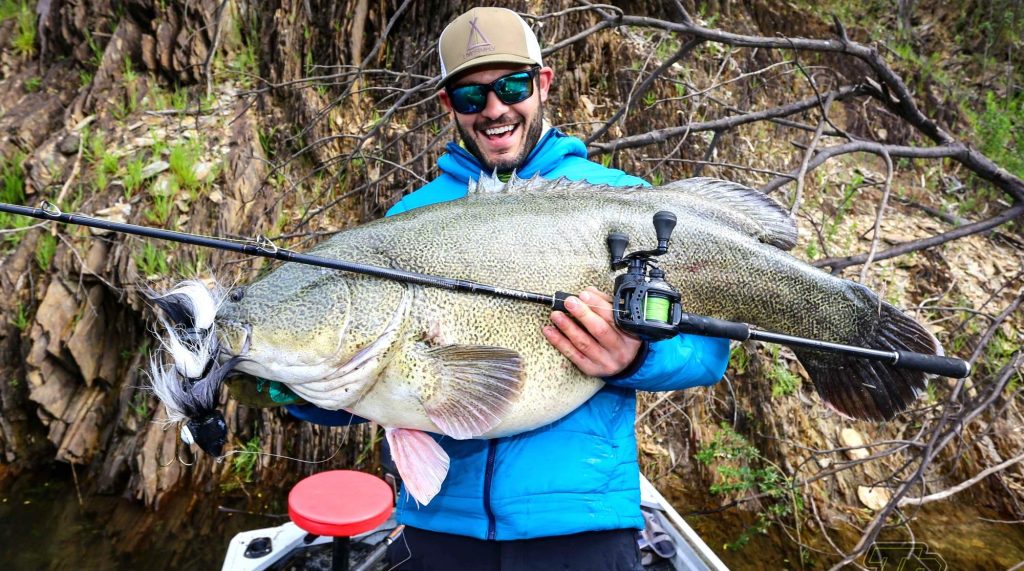
Rod guides play an important role in distributing forces along the length of your rod.
In general, it’s better to consider more guides when it comes to swimbait rods because you get finer control over your rod tip and cast as the guides get smaller towards the end.
The weight of the fishing line that swimbait rods are rated for varies considerably. Since swimbait lures are typically quite heavy, it’s important that your rod is able to handle heavier line weights. Swimbait rods like the one from Ardent, which is limited to line weights around 14 pounds, can be somewhat limiting as you try to catch larger fish. Most other swimbait rods offer line weight ratings of 15 to 40 pounds.
Lure weight is a huge consideration when choosing a swimbait rod – after all, you’re probably investing in this type of rods because you want to use heavier swimbait lures. Crankbait rods can handle swimbait lures that are around two ounces or less, so ideally your swimbait rod will be able to handle lures that are between about two and eight ounces. This is the range found on the Dobyns DC rod.
Note that rods like the KastKing, which is limited to lures less than one ounce in weight, are similar to crankbait rods. This rod is an excellent choice for using smaller swimbaits. However, if you are looking to use heavier swimbaits, we recommend you Okuma swimbait rod.
The overall weight of your swimbait rod is a secondary concern when choosing a new rod, but it is worth to mention it. If you spend the entire day out on the lake, a heavy rod can be tiring to hold after a while. Unfortunately, rods with larger lure and line weight ratings, like the Okuma and Dobyns DC rods, tend to be heavier. So, be realistic about what you’re likely to fish before choosing a larger, heavier swimbait rod.
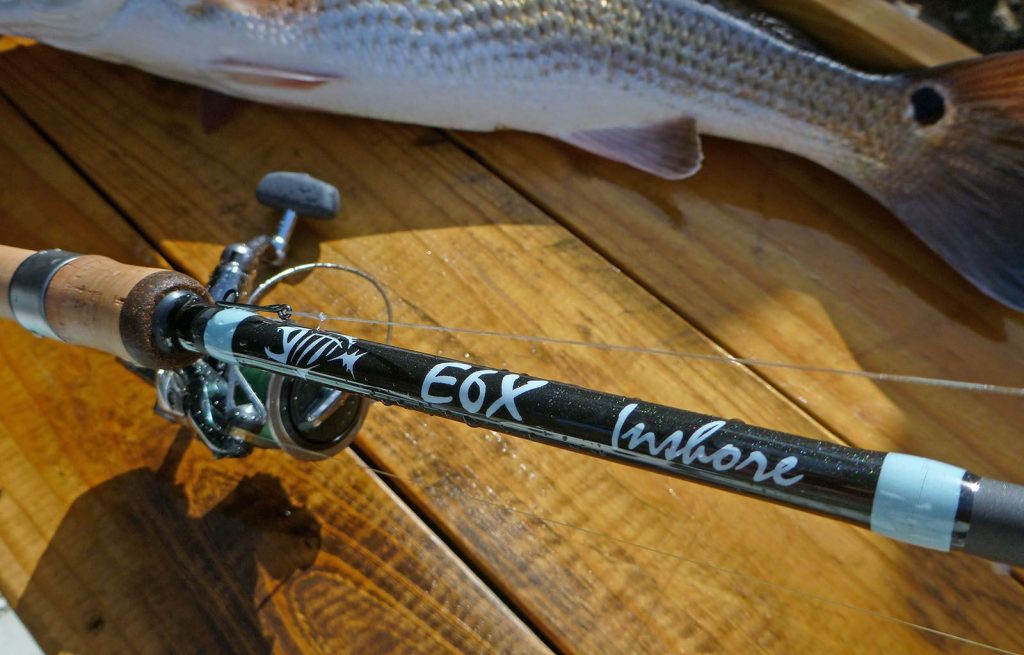
It’s also important to think about the grip material. The Dobyns DC and Ardent rods have cork grips, which many fishermen find to be the most comfortable. But, some fishermen prefer the feel of a synthetic grip, like on the Okuma rod.
Balance is hard to measure, but it’s an important quality of every fishing rod. Ideally, your swimbait rod should feel balanced in your hands so that you’re not putting a lot of energy into holding it upright when you don’t have a fish on the line.
The best way to judge whether a swimbait rod is well-balanced is to check for feedback from experienced fishermen.
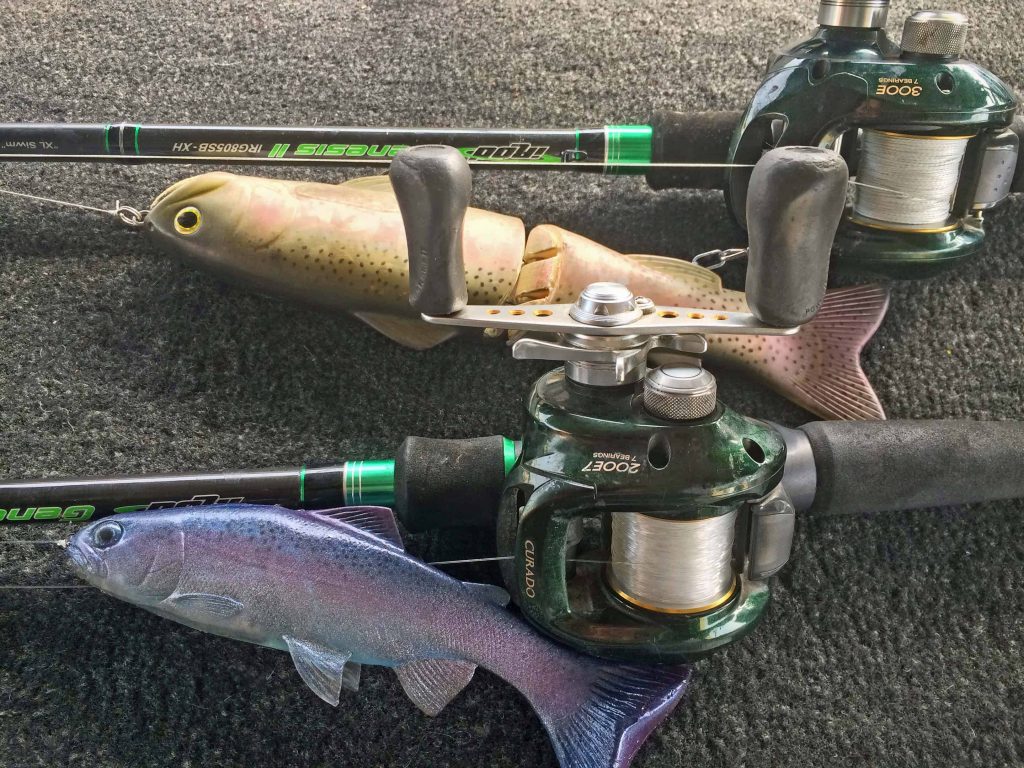
It’s also important to think about the type of reel you plan to use with your fishing rod.
Your rod needs to be compatible with either a baitcaster reel or a lightweight spinning reel, depending on which one you are more comfortable with using. Ultimately, which type of reel is better for swimbait fishing comes down to personal preference.
Swimbait rods aren’t excessively expensive, but they are a significant investment in your fishing setup. Typically, you can expect to spend between $100 and $125 on a new swimbait rod, not counting the reel, line, and lures. For example, the KastKing, Dobyns Fury, Ardent, and Okuma rods all cost around $110 to $120.
However, premium rods like the Loomis or Dobyns DC are significantly more expensive. Both of these rods cost around $250 to $260.
Our three overall favorite swimbait rods on the market today are the Okuma Gide Select A Series rod, the Dobyns Rods Fury FR 806SB, and the KastKing Speed Demon Pro Tournament Series rod.
The KastKing rod is a durable and well-balanced option if you want to buy your first swimbait rod. It is a perfect pick for smaller single-hook lures.
The Dobyns rod has all the necessary characteristics to cast for large fish remaining a budget-friendly option.
We felt that the Okuma rod is the overall best swimbait rod for the majority of bass fishers thanks to its classic swimbait features and durable, balanced construction. The rod is comfortable to hold and offers plenty of backbone for most fishers without feeling excessively stiff or ripping out too fast after landing a bite.

